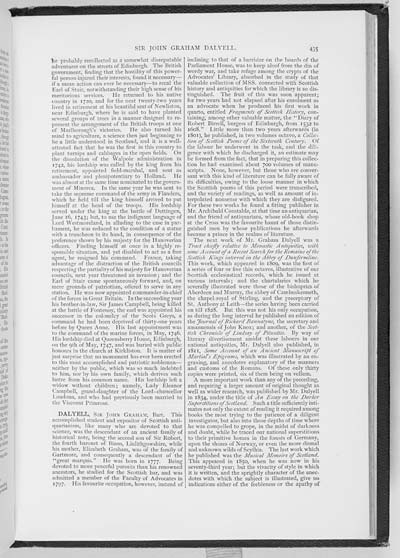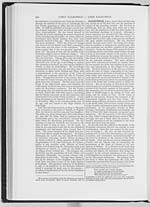Volume 1 > Half-Volume 2
(162) Page 435 - Dalyell, Sir John Graham
Download files
Individual page:
Thumbnail gallery: Grid view | List view

435 he probably recollected as a somewhat disreputable adventurer on the streets of Edinburgh. The British government, finding that the hostility of this power- ful person injured their interests, found it necessary� if a mean action can ever be necessary�to recal the Earl of Stair, notwithstanding their high sense of his meritorious services. He returned to his native country in 1720, and for the next twenty-two years lived in retirement at his beautiful seat of Newliston, near Edinburgh, where he is said to have planted several groups of trees in a manner designed to re- present the arrangement of the British troops at one of Marlborongh's victories. He also turned his mind to agriculture, a science then just beginning to be a little understood in Scotland, and it is a well- attested fact that he was the first in this country to plant turnips and cabbages in the open fields. On the dissolution of the Walpole administration in 1742, his lordship was called by the king from his retirement, appointed field-marshal, and sent as ambassador and plenipotentiary to Holland. He was almost at the same time nominated to the govern- ment of Minorca. In the same year he was sent to take the supreme command of the army in Flanders, which he held till the king himself arrived to put himself at the head of the troops. His lordship served under the king at the battle of Dettingen, June 16, 1743; but, to use the indignant language of Lord Westmoreland, in alluding to the case in par- liament, he was reduced to the condition of a statue with a truncheon in its hand, in consequence of the preference shown by his majesty for the Hanoverian officers. Finding himself at once in a highly re- sponsible situation, and yet disabled to act as a free agent, he resigned his command. France, taking advantage of the distraction of the British councils respecting the partiality of his majesty for Hanoverian councils, next year threatened an invasion; and the Earl of Stair came spontaneously forward, and, on mere grounds of patriotism, offered to serve in any station. He was now appointed commander-in-chief of the forces in Great Britain. In the succeeding year his brother-in-law, Sir James Campbell, being killed at the battle of Fontenoy, the earl was appointed his successor in the colonelcy of the Scots Greys, a command he had been deprived of thirty-one years before by Queen Anne. His last appointment was to the command of the marine forces, in May, 1746. His lordship died at Queensberry House, Edinburgh, on the 9th of May, 1747, and was buried with public honours in the church at Kirkliston. It is matter of just surprise that no monument has ever been erected to this most accomplished and patriotic nobleman� neither by the public, which was so much indebted to him, nor by his own family, which derives such lustre from his common name. His lordship left a widow without children; namely, Lady Eleanor Campbell, grand-daughter of the Lord-chancellor Loudoun, and who had previously been married to the Viscount Primrose. DALYELL, SIR JOHN GRAHAM, Bart. This accomplished student and expositor of Scottish anti- quarianism, like many who are devoted to that science, was the descendant of an ancient family of historical note, being the second son of Sir Robert, the fourth baronet of Binns, Linlithgowshire, while his mother, Elizabeth Graham, was of the family of Gartmore, and consequently a descendant of the "great marquis." He was born in 1777. Being devoted to more peaceful pursuits than his renowned ancestors, he studied for the Scottish bar, and was admitted a member of the Faculty of Advocates in 1797. His favourite occupation, however, instead of inclining to that of a barrister on the boards of the Parliament House, was to keep aloof from the din of wordy war, and take refuge among the crypts of the Advocates' Library, absorbed in the study of that valuable collection of MSS. connected with Scottish history and antiquities for which the library is so dis- tinguished. The fruit of this was soon apparent; for two years had not elapsed after his enrolment as an advocate when he produced his first work in quarto, entitled Fragments of Scottish History, con- taining, among other valuable matter, the "Diary of Robert Birrell, burgess of Edinburgh, from 1532 to 1608." Little more than two years afterwards (in 1801), he published, in two volumes octavo, a Collec- tion of Scottish Poems of the Sixteenth Century. Of the labour he underwent in the task, and the dili- gence with which he discharged it, an estimate may be formed from the fact, that in preparing this collec- tion he had examined about 700 volumes of manu- scripts. None, however, but those who are conver- sant with this kind of literature can be fully aware of its difficulties, owing to the loose manner in which the Scottish poems of this period were transcribed, and the variety of readings, as well as amount of in- terpolated nonsense with which they are disfigured. For these two works he found a fitting publisher in Mr. Archibald Constable, at that time an antiquarian, and the friend of antiquarians, whose old-book shop at the Cross was the favourite haunt of those distin- guished men by whose publications he afterwards became a prince in the realms of literature. The next work of Mr. Graham Dalyell was a Tract chiefly relative to Monastic Antiquities, with some Account of a Recent Search for the Remains of the Scottish Kings interred in the Abbey of Dunfermline. This work, which appeared in 1809, was the first of a series of four or five thin octavos, illustrative of our Scottish ecclesiastical records, which he issued at various intervals; and the chartularies which he severally illustrated were those of the bishoprics of Aberdeen and Murray, the abbey of Cambuskenneth, the chapel-royal of Stirling, and the preceptory of St. Anthony at Leith�the series having been carried on till 1828. But this was not his only occupation, as during the long interval he published an edition of the Fournal of Richard Bannatyne, the secretary and amanuensis of John Knox; and another, of the Scot- tish Chronicle of Lindsay of Pitscottie. By way of literary divertisement amidst these labours in our national antiquities, Mr. Dalyell also published, in 1811, Some Account of an Ancient Manuscript of Martia's Epigrams, which was illustrated by an en- graving, and anecdotes explanatory of the manners and customs of the Romans. Of these only thirty copies were printed, six of them being on vellum. A more important work than any of the preceding, and requiring a larger amount of original thought as well as wider research, was published by Mr. Dalyell in 1834, under the title of An Essay on the Darker Superstitions of Scotland. Such a title sufficiently inti- mates not only the extent of reading it required among books the most trying to the patience of a diligent investigator, but also into those depths of time where he was compelled to grope, in the midst of darkness and doubt, while he traced our national superstitions to their primitive homes in the forests of Germany, upon the shores of Norway, or even the more dismal and unknown wilds of Scythia. The last work which he published was the Musical Memoirs of Scotland. This appeared in 1850, when he was now in his seventy-third year; but the vivacity of style in which it is written, and the sprightly character of the anec- dotes with which the subject is illustrated, give no indications either of the feebleness or the apathy of
Set display mode to:
![]() Universal Viewer |
Universal Viewer | ![]() Mirador |
Large image | Transcription
Mirador |
Large image | Transcription
Images and transcriptions on this page, including medium image downloads, may be used under the Creative Commons Attribution 4.0 International Licence unless otherwise stated. ![]()
| Biographical dictionary of eminent Scotsmen > Volume 1 > Half-Volume 2 > (162) Page 435 - Dalyell, Sir John Graham |
|---|
| Description | Spine title: Half-Vol. II. Campbell to Erskine. |
|---|---|
| Description | Volume I. Contains names alphabetically from Abercromby to Erskine. |
|---|

